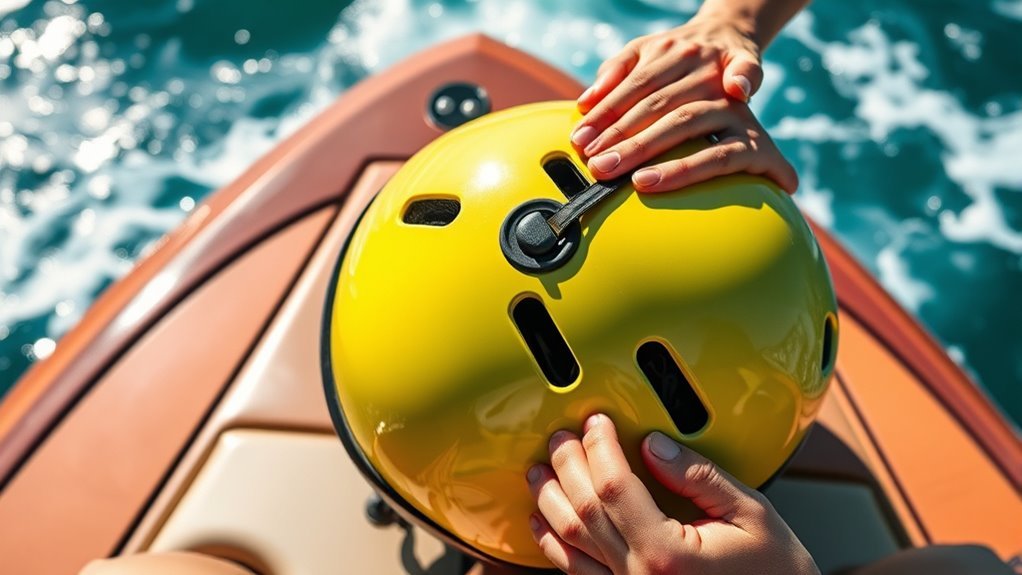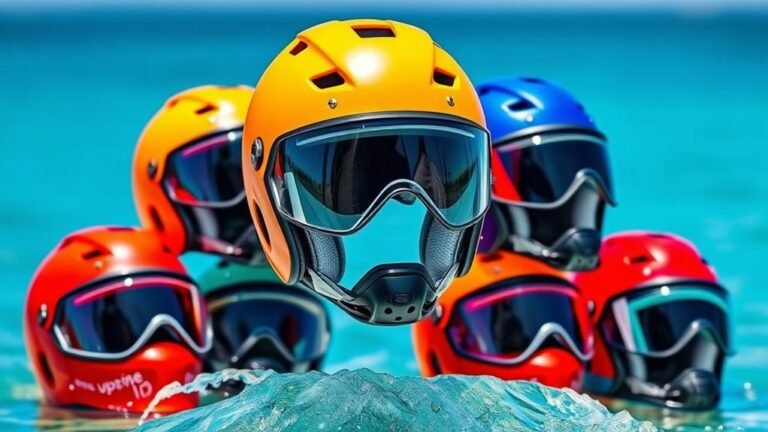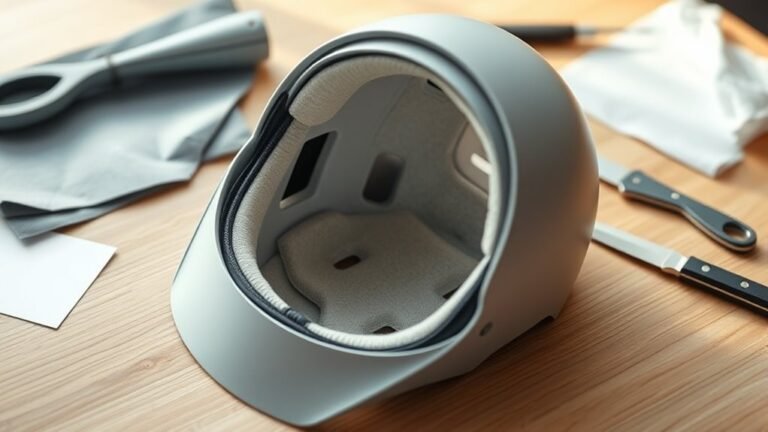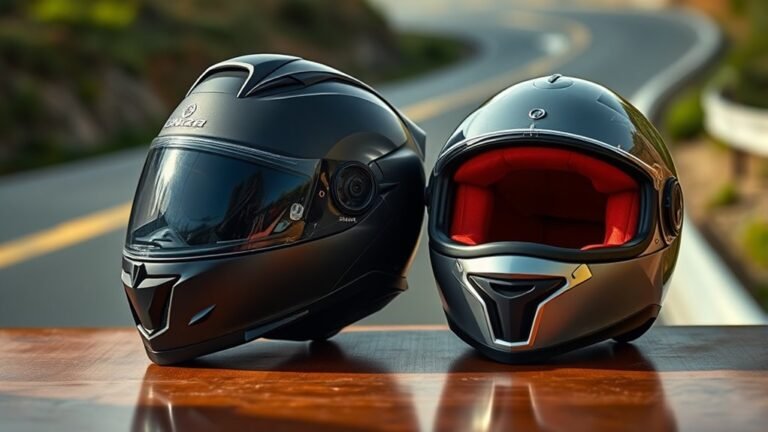How to Secure Your Helmet While on Watercraft
To secure your helmet while on watercraft, make certain it fits snugly and adjust the chin strap for a tight but comfortable hold. Check that side straps are stable and allow for easy movement without slipping. Utilize additional retention systems if available for extra security. Ascertain your helmet doesn’t obstruct your view or hearing. Regular checks before use enhance safety. For more tips on maintaining a secure fit and peak performance, keep exploring your options.
Choosing the Right Helmet for Water Activities
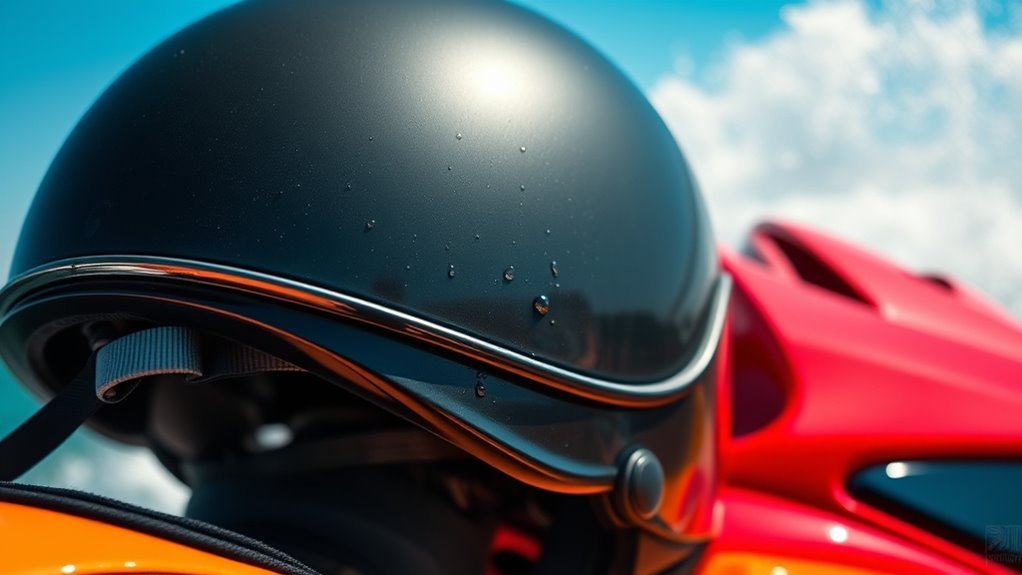
When you’re out on the water, choosing the right helmet for your activities is essential for safety and comfort. Water sports helmets are specifically designed to protect your head from impacts and provide good ventilation. Look for helmets that meet helmet safety standards, ensuring they can withstand the rigors of water sports. Check for features like adjustable straps and lightweight materials, which enhance your experience without compromising safety. Consider the type of activity you’ll be doing—whether it’s wakeboarding, kayaking, or jet skiing—since different sports may require different specifications. Investing in a high-quality helmet not only safeguards you but also allows you to embrace your freedom on the water with confidence. Make your choice wisely and gear up for adventure!
Adjusting the Fit for Maximum Comfort
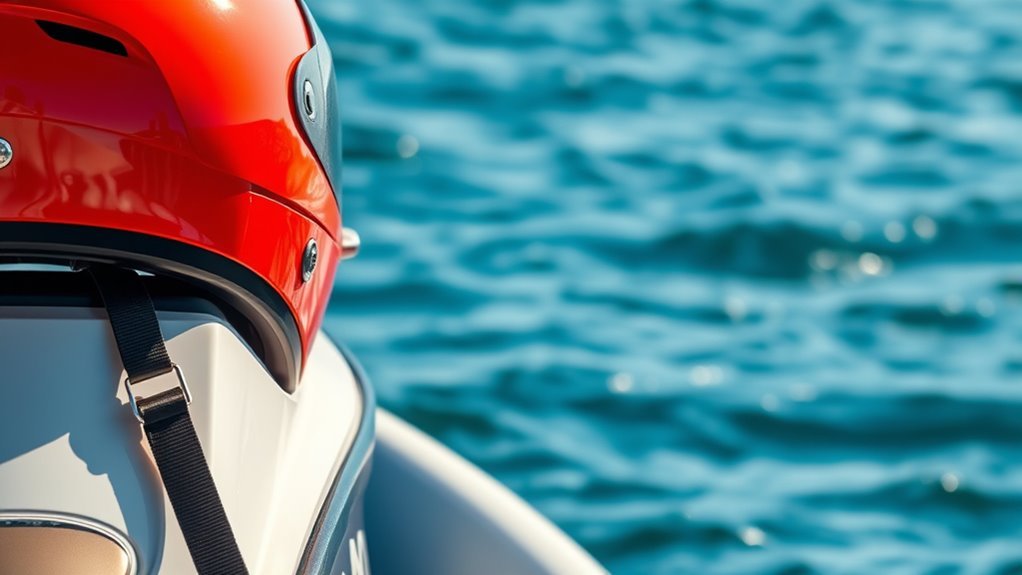
To guarantee maximum comfort, you need to adjust your helmet properly. Start by fine-tuning the straps and checking the padding for a snug fit. Choosing the right size is also essential, as it affects both comfort and safety while you’re on the water.
Proper Strap Adjustment
Securing your helmet properly hinges on adjusting the straps for the best fit and comfort. To achieve this, start by ensuring the strap tightness is appropriate—not too loose that it shifts during your ride, and not too tight that it causes discomfort. You should be able to fit one or two fingers between the strap and your chin. Adjust the side straps to maintain helmet stability, keeping it snug without impeding your movement. When you tilt your head, the helmet should stay in place without excessive wobbling. Remember, a well-fitted helmet enhances your freedom on the water, allowing you to focus on the thrill of the ride instead of worrying about safety. Prioritize proper strap adjustment for the ultimate experience.
Padding and Interior Fit
While you might have the straps adjusted perfectly, the helmet’s padding and interior fit play an essential role in overall comfort and protection. Make certain you’re using high-quality padding materials that conform to your head shape. This guarantees that the helmet not only feels snug but also absorbs impact effectively. Pay attention to the interior cushioning; it should provide a balance between firmness and softness, allowing for extended wear without discomfort. If you find your helmet lacks adequate padding, consider adding aftermarket inserts designed for a tailored fit. Remember, a well-padded helmet enhances your freedom on the water, allowing you to focus on the ride instead of discomfort or distractions. Prioritize comfort to enjoy your adventures fully.
Helmet Size Selection
Choosing the right helmet size is crucial for ensuring maximum comfort and protection on the water. To achieve the best helmet sizing, follow these measurement techniques:
| Measurement Method | Instructions |
|---|---|
| Head Circumference | Measure around the forehead, above the ears. |
| Fit Test | Place the helmet on your head; it should sit snugly without pressure points. |
| Adjustment | Use chin straps and padding to customize the fit. |
Understanding the Chin Strap and Its Importance
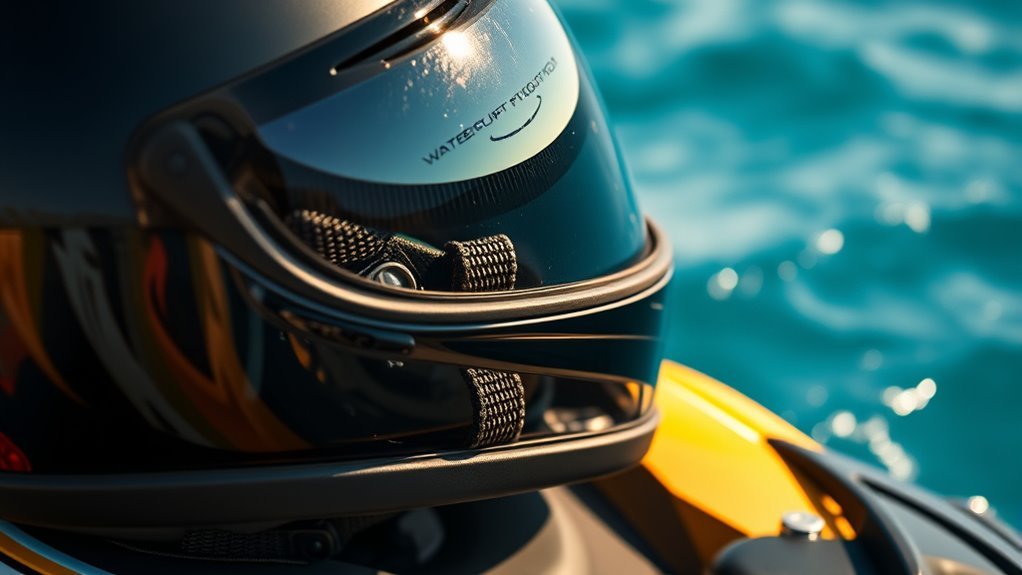
Although you might not give it much thought, the chin strap is an essential component of your helmet when you’re out on the water. It keeps your helmet securely in place, guaranteeing it won’t shift or come off during high-speed maneuvers. There are several chin strap types, including adjustable and quick-release options, each offering varying levels of convenience and security. The strap materials also play a significant role; nylon and polyester are popular for their durability and water resistance. Choosing the right chin strap guarantees your helmet remains snug, allowing you to enjoy the freedom of the water without worrying about safety. Always check the strap’s condition before heading out—it’s your lifeline to protection on the waves.
Utilizing Additional Retention Systems
To enhance the security of your helmet on watercraft, consider utilizing additional retention systems. These safety accessories can greatly reduce the risk of losing your helmet during high-speed activities. Retention devices like helmet tethers, chin straps, and adjustable fit systems provide extra stability and protection.
Here’s a quick overview of effective options:
| Retention Device | Description | Benefits |
|---|---|---|
| Helmet Tether | Connects helmet to watercraft | Prevents loss during falls |
| Chin Strap | Secures helmet under the chin | Keeps helmet in place |
| Adjustable Fit System | Customizes fit for comfort | Enhances security and comfort |
| Quick Release Buckle | Easy to detach when necessary | Convenient for quick access |
| Padding Inserts | Adds comfort and stability | Reduces movement of the helmet |
These systems guarantee your helmet stays secured, allowing you to focus on enjoying your ride.
Checking for Proper Visibility and Hearing
How can you guarantee your helmet doesn’t obstruct your visibility and hearing while on the water? First, make certain your helmet fits snugly but comfortably. Adjust the visor to avoid glare, and check that it doesn’t limit your peripheral vision. Be mindful of visibility conditions; if the sun’s bright or you’re riding into the wind, a clear view’s vital.
Next, consider your hearing protection. While it’s essential to shield your ears from loud noises, make sure the helmet doesn’t muffle important sounds, like approaching watercraft or emergency signals. You want to enjoy the ride, but staying aware enhances your safety. Always test your helmet before heading out to make sure it strikes the right balance between protection and freedom.
Performing a Safety Check Before You Ride
Before you hit the water, it’s essential to perform a safety check on your helmet. Make certain it fits snugly and that the fastening mechanism is secure. Also, assess your visibility and comfort to guarantee a safe ride.
Inspect Your Helmet Fit
A proper helmet fit is essential for safety on the water. If your helmet doesn’t fit correctly, it can compromise helmet safety and leave you vulnerable. Here’s how to guarantee your helmet fits snugly:
| Fit Test | What to Check | Action Required |
|---|---|---|
| Forehead | Should sit 1 inch above eyebrows | Adjust padding or straps |
| Side to Side | No wobbling or movement | Tighten or replace strap |
| Back to Front | Shouldn’t slide back or forward | Adjust chin strap |
| Overall Comfort | Comfortable and secure feel | Replace if necessary |
Regular helmet maintenance is key to keeping your gear effective. Inspect your helmet fit before every ride to enjoy your freedom on the water without worry.
Check Fastening Mechanism
Making sure your helmet’s fastening mechanism is secure is essential for your safety on the water. Before you ride, take a moment to check the fastening types of your helmet. A secure fit means you can focus on enjoying your adventure. Here’s what to look for:
- Buckle: Make sure it clicks firmly and isn’t loose.
- Straps: Check for wear and tear; they should be intact and adjust easily.
- Retention system: Confirm it holds the helmet snugly without discomfort.
- Padding: Inspect for proper alignment to prevent slippage.
Assess Visibility and Comfort
How well can you see while wearing your helmet? Your visibility concerns are essential for a safe and enjoyable ride. Before you hit the water, assess your comfort levels and make sure your helmet doesn’t obstruct your view. Here’s a quick checklist:
| Visibility Check | Comfort Level | Action Needed |
|---|---|---|
| Clear peripheral vision | Feels snug, not tight | Adjust padding |
| No fogging or glare | Breathable materials | Swap for a ventilated helmet |
| Stable fit at speed | Lightweight design | Choose a lighter model |
| Unobstructed view | No pressure points | Readjust straps |
| Easily adjustable | Satisfactory fit | Test before riding |
Make sure you’ve got ideal visibility and comfort to enjoy your freedom on the water safely!
Tips for Keeping Your Helmet Secure During Use
Keeping your helmet secure while on a watercraft is crucial for safety—five simple tips can help. By following these guidelines, you’ll enjoy your ride with peace of mind.
- Confirm your helmet fits snugly; adjust the straps for maximum security.
- Use a helmet storage bag to keep it safe when not in use, preventing damage.
- Check for wear and tear regularly; proper helmet maintenance prolongs its lifespan.
- Use a chin strap to fasten it securely, preventing it from flying off during fast maneuvers.
Frequently Asked Questions
Can I Wear a Regular Bicycle Helmet on Watercraft?
You shouldn’t wear a regular bicycle helmet on watercraft. These helmets often don’t meet the safety standards required for water activities, and their fit isn’t designed for high-speed impacts or water conditions. Watercraft helmets are specifically made to protect against the unique risks associated with aquatic sports. You want to guarantee your helmet fits properly to maximize protection, so invest in a helmet designed for watercraft use for your safety.
How Often Should I Replace My Helmet?
Your helmet’s like a trusty steed; it needs care and timely replacement. Generally, a helmet’s lifespan is about three to five years, but look for replacement signs like cracks, dents, or worn padding. If you’ve had a hard impact, don’t gamble—replace it immediately. Staying safe means knowing when it’s time to let go of the old and embrace a new one. Freedom on the water starts with a reliable helmet!
What Materials Are Best for Water Helmets?
When choosing materials for water helmets, look for options like polycarbonate, fiberglass, and carbon fiber. Polycarbonate offers durability and impact resistance at a lower price, while fiberglass combines lightweight strength with good durability. Carbon fiber is the top choice for serious riders, providing exceptional strength and minimal weight but at a higher cost. In a materials comparison, prioritize what suits your needs best, ensuring your helmet remains both durable and effective for your adventures.
Are There Specific Helmets for Different Watercraft?
Just like a knight picks different armor for various battles, you’ll want specific helmets for different watercraft. Each type offers unique helmet features tailored for watercraft safety. For instance, a jet ski helmet’s designed for high-speed impact, while a kayaking helmet focuses on protection against rolling waves. When you choose wisely, you’re not just riding; you’re embracing freedom while ensuring your safety. So gear up and conquer those waters with confidence!
How Do I Clean My Helmet Properly?
To clean your helmet properly, start by removing any removable padding and using a soft brush to remove dirt. For the shell, use mild soap mixed with warm water or specific cleaning solutions designed for helmets. Avoid harsh chemicals. Rinse thoroughly and let it air dry. Regular helmet maintenance tips include checking for scratches and ensuring all parts are secure to enhance longevity and performance, keeping your adventures safe and enjoyable.
